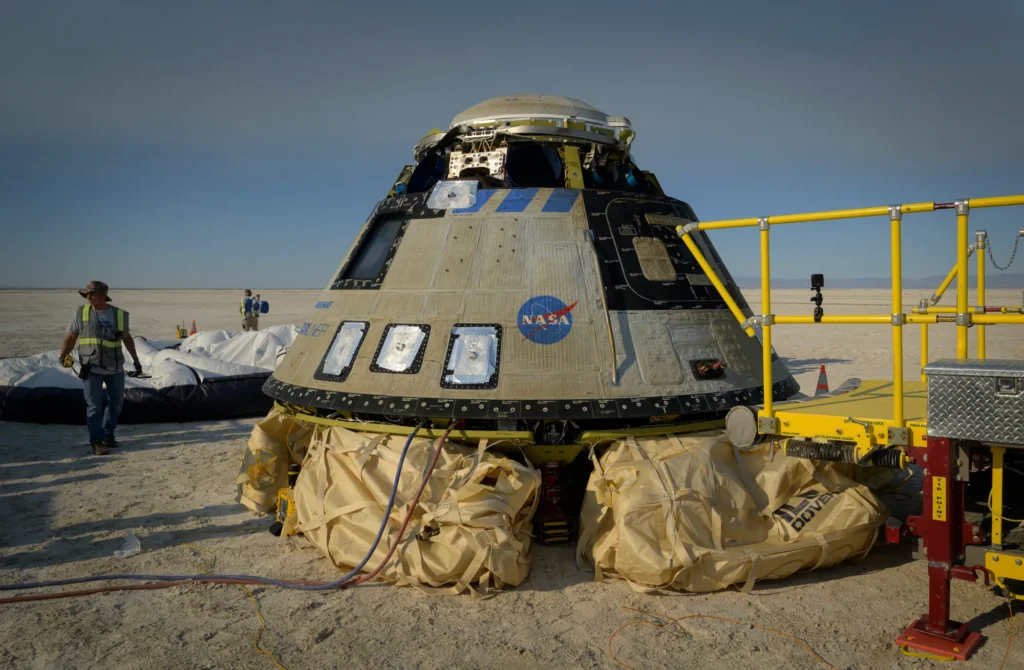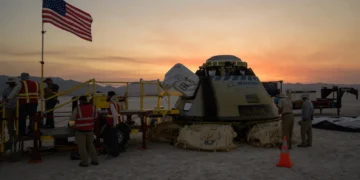NASA and Boeing have been working tirelessly to ensure the safe return of the Starliner spacecraft from its missions to the International Space Station (ISS). The spacecraft’s return is a carefully coordinated process involving numerous checks, procedures, and safety measures that ensure both mission success and crew safety. Let’s explore the details of Starliner’s landing strategy, the science behind it, and why it marks an important milestone for future space missions.
Starliner’s Landing Criteria and Preparations
Before any landing, the safety of the spacecraft, crew, and cargo is of utmost importance. To guarantee this, NASA and Boeing implement a comprehensive set of landing criteria and checks 24 hours before the spacecraft undocks from the ISS. These checks involve precise weather and operational evaluations for potential landing sites, such as White Sands Missile Range in New Mexico, Willcox Playa in Arizona, Dugway Proving Ground in Utah, and Edwards Air Force Base in California as a contingency site. Wind speeds must be under 6 mph for crewed flights and under 13 mph for uncrewed ones. Ground temperatures must be above 15 degrees Fahrenheit, and the visibility must extend to at least one nautical mile. Additionally, there should be no thunderstorms, precipitation, or lightning within a 22-mile radius.
A miscalculation or adverse weather could jeopardize the mission and pose risks to both the spacecraft and crew. By monitoring these variables closely, NASA ensures that the landing process has the highest possible chances of success. If conditions are unfavorable at a planned site, they delay the deorbit burn and target another landing attempt within the next 24 to 31 hours.
The Re-Entry and Landing Process
Re-entry into Earth’s atmosphere is one of the most critical phases of any space mission. For Starliner, this process begins with a series of carefully coordinated maneuvers. After undocking from the ISS, Starliner performs several departure burns to distance itself from the space station. This is followed by a deorbit burn lasting approximately 60 seconds, which slows the spacecraft enough to initiate re-entry into Earth’s atmosphere. Immediately after the deorbit burn, the spacecraft’s service module separates and burns up over the southern Pacific Ocean. This separation clears the way for the command module—the part that contains the crew and critical systems—to proceed with re-entry.

NASA/Bill Ingalls
During re-entry, Starliner experiences extreme temperatures as it encounters atmospheric friction. The spacecraft’s heat shields, both forward and base, are critical in protecting it from temperatures that can reach up to 3,000 degrees Fahrenheit. As the spacecraft descends, it deploys a series of parachutes to slow its speed. At 30,000 feet, the forward heat shield is jettisoned, releasing two drogue parachutes that stabilize the spacecraft’s descent. These are followed by three main parachutes that further reduce the descent speed. At 3,000 feet, the base heat shield is released, allowing six landing airbags to inflate, cushioning the impact as the Starliner lands at a gentle 4 mph.
This sequence of actions is crucial for ensuring a controlled descent and a safe landing. Unlike traditional water landings, the Starliner’s ability to land on solid ground allows for faster recovery operations and reduces the wear and tear on the spacecraft, making it easier and quicker to refurbish for future missions.
Coordinated Recovery Operations
After the Starliner safely touches down, a highly coordinated recovery operation is initiated to ensure the spacecraft’s safety and quick turnaround for future use. The recovery process is divided into five distinct teams, each responsible for specific tasks to secure the spacecraft, ensure crew safety, and manage the retrieval of time-sensitive cargo.
The first team to approach the spacecraft is the Gold Team, which uses specialized equipment to detect any remaining hypergolic fuels that could pose a hazard. Hypergolic fuels are highly reactive and can cause serious damage if not fully burned off during re-entry. By confirming that these fuels are no longer a threat, the team ensures a safe environment for the subsequent recovery teams.
Once the Gold Team gives the all-clear, the Silver Team moves in to electrically ground the spacecraft and stabilize it. This step prevents any static discharge or electrical hazards that could damage the spacecraft or its contents. The Green Team follows, providing power and cooling to the crew module since it is powered down during descent. Maintaining optimal conditions is essential for preserving both the spacecraft’s systems and any critical experiments or samples being returned from the ISS.
Next is the Blue Team, which documents the recovery process for public dissemination and future reviews. This documentation is crucial for improving future missions, providing a detailed record of every step taken during recovery. Finally, the Red Team, which includes fire rescue, emergency medical technicians, and human factors engineers, approaches the spacecraft to open the hatch and retrieve time-critical cargo.
Importance for Future Space Missions
The Starliner’s ability to perform land-based landings offers several advantages that are crucial for the future of space missions. One of the most significant benefits is the reduced time needed for recovery and refurbishment. Unlike water landings, which require extensive efforts to retrieve and transport the spacecraft back to a facility for refurbishment, land-based landings allow for faster access to the spacecraft. This quicker turnaround means that Starliner can be prepared for its next mission much sooner, reducing downtime and overall costs.
Furthermore, the ability to recover the spacecraft quickly and efficiently aligns with NASA’s goals under the Commercial Crew Program. This program aims to provide safe, reliable, and cost-effective transportation for astronauts to and from the ISS. By fostering competition between Boeing’s Starliner and SpaceX’s Crew Dragon, NASA encourages innovation and cost reduction in human spaceflight. This competition drives technological advancements that are not only beneficial for NASA but also have the potential to open up space travel to a wider range of participants, including private companies and international partners.
Lessons Learned and Future Improvements
Every mission presents an opportunity to learn and improve, and the Starliner program is no exception. Past missions have already led to several important updates, such as improvements in software, safety protocols, and communication systems. For example, after the initial test flights, Boeing implemented software updates to address issues related to navigation and communication with mission control. These improvements are essential for ensuring the safety and reliability of future crewed and uncrewed missions.
The iterative process of testing, learning, and refining is key to advancing space exploration. As NASA and Boeing continue to collaborate on the Starliner program, they remain focused on enhancing the spacecraft’s reliability and safety. This commitment to continuous improvement ensures that the Starliner will be better prepared to meet the demands of future space missions, whether they involve transporting astronauts to the ISS or supporting longer-duration missions to the Moon and Mars.
Conclusion
NASA’s Starliner mission, in partnership with Boeing, represents a monumental leap forward in space exploration and spacecraft recovery. The mission’s focus on safe landings, coordinated recovery operations, and continuous improvements sets a high standard for future space missions. As NASA continues to work closely with commercial partners, the Starliner program demonstrates the value of public-private partnerships in driving innovation and expanding the possibilities of human space exploration.
With each successful mission, we gain valuable insights that help shape the future of space travel. The lessons learned from the Starliner program will not only benefit missions to the ISS but also serve as a foundation for more ambitious endeavors, including journeys to the Moon, Mars, and beyond. As we look to the future, the collaboration between NASA, Boeing, and other industry partners will be crucial in achieving our goals and exploring the vast unknowns of space.
Reference:
Johnson Space Center Office of Communications. (2024, September 5). NASA’s Boeing Starliner Mission Landing Criteria, Timeline. NASA. https://www.nasa.gov/commercialcrew



















